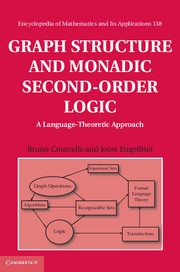Book contents
- Frontmatter
- Contents
- Foreword
- Introduction
- 1 Overview
- 2 Graph algebras and widths of graphs
- 3 Equational and recognizable sets in many-sorted algebras
- 4 Equational and recognizable sets of graphs
- 5 Monadic second-order logic
- 6 Algorithmic applications
- 7 Monadic second-order transductions
- 8 Transductions of terms and words
- 9 Relational structures
- Conclusion and open problems
- References
- Index of notation
- Index
Foreword
Published online by Cambridge University Press: 05 July 2012
- Frontmatter
- Contents
- Foreword
- Introduction
- 1 Overview
- 2 Graph algebras and widths of graphs
- 3 Equational and recognizable sets in many-sorted algebras
- 4 Equational and recognizable sets of graphs
- 5 Monadic second-order logic
- 6 Algorithmic applications
- 7 Monadic second-order transductions
- 8 Transductions of terms and words
- 9 Relational structures
- Conclusion and open problems
- References
- Index of notation
- Index
Summary
The genesis of this great and beautiful book spans more than 20 years. It collects and unifies many theoretical notions and results published by Bruno Courcelle and others in a large number of articles.
The concept of a language to communicate with a computer, a machine or any kind of device performing operations is at the heart of Computer Science, a field that has truly thrived with the emergence of symbolic programming languages in the 1960s. Formalizing the algorithms that enable computers to calculate an intended result, to control a machine or a robot, to search and find the relevant information in response to a query, and even to imitate the human brain in actions such as measuring risk and making decisions, is the main activity of computer scientists as well as of ordinary computer users.
The languages designed for these tasks, which number by thousands, are defined in the first place by syntactic rules that construct sets of words and to which are then attached meanings. This understanding of a language was first conceived by structural linguists, in particular Nicolaï Troubetskoï, Roman Jacobson and Noam Chomsky, and has transformed Linguistics, the study of natural languages, by giving it new directions. It has also been extended to programming languages, which are artificial languages, and to the Lambda Calculus, one of many languages devised by logicians, among whom we can cite Kurt Gödel, Alonzo Church and Alan Turing, who aspired to standardize mathematical notation and to mechanize proofs.
- Type
- Chapter
- Information
- Graph Structure and Monadic Second-Order LogicA Language-Theoretic Approach, pp. xi - xivPublisher: Cambridge University PressPrint publication year: 2012

